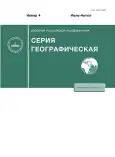Climatic factors of the Volga runoff variability in the second half of 20th – early 21st centuries
- Authors: Popova V.V.1, Babina E.D.1, Georgiadi A.G.1
-
Affiliations:
- Institute of Geography, Russian Academy of Sciences
- Issue: No 4 (2019)
- Pages: 63-72
- Section: NATURAL PROCESSES AND DYNAMICS OF GEOSYSTEMS
- URL: https://journals.eco-vector.com/2587-5566/article/view/15857
- DOI: https://doi.org/10.31857/S2587-55662019463-72
- ID: 15857
Cite item
Abstract
The relation of the Volga runoff to the change of climatic factors, significant for the river runoff, is considered since the middle of the last century. The quantitative estimates of the impact of precipitation anomalies (taking into account the solid and liquid phase) on the variability of the annual runoff of the Volga show that the leading role of solid precipitation is detected in the period preceding the current warming (from the early 1950s to the mid-1970s), and also from the mid-1990s, with the onset of warming hiatus. From the mid-1970s to the 1990s, during the period of winter temperature growth, a significant increase in the role of liquid precipitation and their dominance in the variability of the Volga's runoff is observed. The differences between these periods are also noticeable in the percentage of liquid precipitation in the annual amount, which in turn has an ambiguous effect on the spring runoff of the Volga. The long-term trends of spring runoff and the share of liquid precipitation (in annual amount) before and after the mid-1970s coincide in sign. In the same time, there is a negative correlation between the anomalies of these parameters in interannual scale. The last indicates a decrease in the volume of runoff in the years of increasing the proportion of liquid precipitation.
Full Text
About the authors
V. V. Popova
Institute of Geography, Russian Academy of Sciences
Email: valeria_popova@mail.ru
Russian Federation, Moscow
E. D. Babina
Institute of Geography, Russian Academy of Sciences
Author for correspondence.
Email: valeria_popova@mail.ru
Russian Federation, Moscow
A. G. Georgiadi
Institute of Geography, Russian Academy of Sciences
Email: valeria_popova@mail.ru
Russian Federation, Moscow
References
- Alekseevsky N.I., Frolova N.L., Antonova M.M., Igonina M.I. Climate changes impact on the regime and runoff of Volga basin rivers. Voda: Khimiya i Ekol., 2013, no. 4, pp. 3-12. (In Russ.).
- Bogdanova E.G., Gavrilova S.Y., Il'in B.M. Time changes of atmospheric precipitation in Russia from the corrected data during 1936-2000. Russ. Meteorol. Hydrol., 2010, vol. 35, no. 10, pp. 706-714.
- Bolgov M.V., Korobkina E.A., Trubetskova M.D., Filimonova M.K., Filippova I.A. Present-day variations of the minimum runoff of the Volga basin rivers. Russ. Meteorol. Hydrol., 2014, vol. 39, no. 3, pp. 187-194.
- Vtoroi otsenochnyi doklad Rosgidrometa ob izmeneniyakh klimata i ikh posledstviyakh na territorii Rossiiskoi Federatsii [Second Roshydromet Assesment Report on Climate Change and its Consequences in the Russian Federation]. Moscow: Rosgidromet Publ., 2014. 1009 p.
- Georgiadi A.G., Koronkevich N.I., Zaitseva I.S., Kashutina E.A., Barabanova E.A. Climatic and anthropogenic factors in multiyear changes of Volga river runoff. Vodnoe Khozyaistvo Rossii, 2013, no. 4, pp. 4-19. (In Russ.).
- Georgievsky V.Yu., Shalygin A.L. Hydrological regime and water resources. In Metody otsenky posledstvii izmenenii klimata dlya fizicheskikh i biologicheskikh sistem [Methods for Assessing the Consequences of Climate Change for Physical and Biological Systems]. Semenov S.M., Ed. Moscow: Rosgidromet Publ., 2012, ch. 2, pp. 53-58. (In Russ.).
- Zaikov B.D. Mnogoletnie kolebaniya stoka Verkhnei Kamy [Multiyear Variation of Upper Kama River Runoff], vol. 13 of Tr. po kompleksnomu izuch. Kaspiiskogo morya [Letters on Complex Study of the Caspian Sea]. Akad. Nauk SSSR, 1940. 53 p.
- Zaitseva I.S. Perannual variations of Volga River run-off and global climate changes. Izv. Akad. Nauk, Ser. Geogr., 1996, no. 5, pp. 45-54. (In Russ.).
- Ismailov G.H., Fedorov V.M. Analysis of the long-term variation of Volga annual runoff. Vodn. Resur., 2001, vol. 25, no. 5, pp. 517-525. (In Russ.).
- Popova V.V. Modern climate change in the north of Eurasia as a manifestation of macro-scale atmospheric circulation variation. Fundamentalnaya i Prikl. Klimatol., 2018, no. 1, pp. 84-112. (In Russ.).
- Popova V.V., Morozova P.A., Titkova T.B., Semenov V.A., Cherenkova E.A., Shiryaeva A.V., Kitaev L.M. Regional features of present winter snow accumulation variability in the North Eurasia from data of observations, reanalysis and satellites. Led i Sneg, 2015, vol. 55, no. 4, pp. 73-86. (In Russ.).
- Shmakin A.B. Climatic characteristics of snow cover of Northern Eurasia and their variation in the last decades. Led i Sneg, 2010, no. 1, pp. 43-57. (In Russ.).
- Shmakin A.B., Turkov D.V., Michailov A.Yu. Model of snow cover with inclusion of layered structure and its seasonal evolution. Kriosfera Zemli, 2009, vol. 13, no. 4, pp. 69-79. (In Russ.).
- England M.H., McGregor S., Spence P., et al. Recent intensification of wind-driven circulation in the Pacific and the ongoing warming hiatus. Nat. Clim. Chang., 2014, vol. 4, no. 3, pp. 222-227.
- Climate Change 2013: The Physical Science Basis. Contribution of Working Group I to the Fifth Assessment Report of the Intergovern- mental Panel on Climate Change. Stocker T.F., Qin D., Plattner G.-K., Tignor M., Allen S.K., Boschung J., Nauels A., Xia Y., Bex V., Midgley P.M., Eds. Cambridge, New York: Cambridge Univ. Press, 2013. 1535 p.
- Petoukhov V., Semenov V. A link between reduced Barents-Kara sea ice and cold winter extremes over northern continents. J. Geophys. Res. Atmos., 2010, vol. 115, no. D21. doi: 10.1029/2009JD013568
- Semenov V., Latif M. Nonlinear winter atmospheric circulation response to Arctic sea ice concentration anomalies for different periods during 1966-2012. Environ. Res. Lett., 2015, vol. 10, no. 5, p. 054020. doi: 10.1088/1748-9326/10/5/054020
- Trenberth K.E., Fasullo J.T. An apparent hiatus in global warming? Earth’s Future, 2013, vol. 1, no.1, pp.19-32. doi: 10.1002/2013EF000165
Supplementary files














